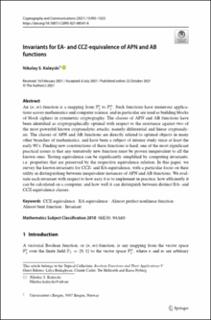Invariants for EA- and CCZ-equivalence of APN and AB functions
Journal article, Peer reviewed
Published version

Åpne
Permanent lenke
https://hdl.handle.net/11250/2986799Utgivelsesdato
2021Metadata
Vis full innførselSamlinger
- Department of Informatics [917]
- Registrations from Cristin [9489]
Sammendrag
An (n,m)-function is a mapping from \({\mathbb {F}_{2}^{n}}\) to \({\mathbb {F}_{2}^{m}}\). Such functions have numerous applications across mathematics and computer science, and in particular are used as building blocks of block ciphers in symmetric cryptography. The classes of APN and AB functions have been identified as cryptographically optimal with respect to the resistance against two of the most powerful known cryptanalytic attacks, namely differential and linear cryptanalysis. The classes of APN and AB functions are directly related to optimal objects in many other branches of mathematics, and have been a subject of intense study since at least the early 90’s. Finding new constructions of these functions is hard; one of the most significant practical issues is that any tentatively new function must be proven inequivalent to all the known ones. Testing equivalence can be significantly simplified by computing invariants, i.e. properties that are preserved by the respective equivalence relation. In this paper, we survey the known invariants for CCZ- and EA-equivalence, with a particular focus on their utility in distinguishing between inequivalent instances of APN and AB functions. We evaluate each invariant with respect to how easy it is to implement in practice, how efficiently it can be calculated on a computer, and how well it can distinguish between distinct EA- and CCZ-equivalence classes.
